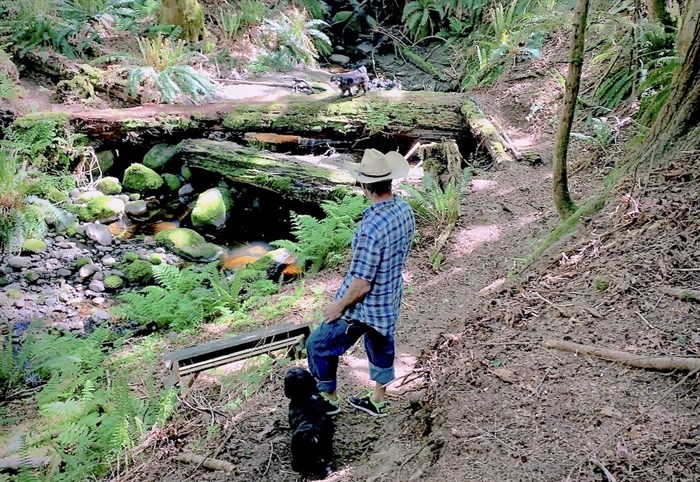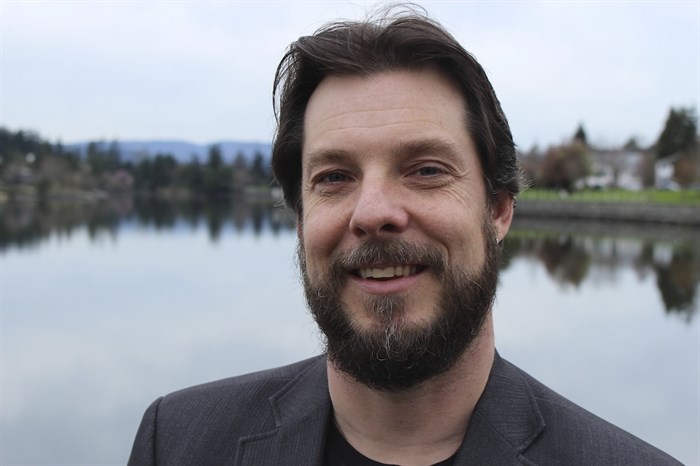
Rural residents concerned with water security get little help from the province as water levels drop and severe summer droughts plague the Vancouver Island region for a third year running.
Image Credit: Rochelle Baker, Local Journalism Initiative
September 10, 2023 - 1:00 PM
B.C.’s small rural communities striving for water security as droughts become the norm still sink or swim without much assistance from the province, policy experts say.
Most of the province has been in the clutches of unprecedented — but long anticipated — climate-induced drought for most of the summer. About 55 per cent of B.C.'s water basins are at Level 5 on the provincial drought scale — the point when adverse socioeconomic or ecosystem impacts are almost certain.
Vancouver Island, renowned for its rainforests, has experienced prolonged severe or extreme drought for the past three summers. In an effort to preserve water for people, fish, livestock and growing food on central Vancouver Island, the province has imposed temporary water restrictions in watersheds for the Tsolum River and Koksilah and Cowichan rivers. Industrial water users and farmers growing water-intensive forage crops have had to shut off their taps. It has also imposed similar measures in the Thompson Okanagan region for hundreds of water licence holders.
However, B.C.’s reactive, piecemeal approach at the height of a water crisis is ineffective, said Oliver Brandes, a lead with the POLIS Water Sustainability Project at the University of Victoria.
“When your home is on fire is not the time to be thinking about how to fireproof the house,” he said.
“We should have been doing a whole bunch of stuff in advance in November, not August.”
Droughts are no longer a 'surprise' emergency

Drought response and water security require comprehensive and proactive advance planning along with clear direction and resources from the province, says water policy expert Oliver Brandes.
Image Credit: SUBMITTED
The extended drought late last fall set the table for today’s provincewide crisis and was predictable given the rising pattern of drought over the past decade, he said.
The province regulates the ground and surface relied on by water rural users who aren’t tapped into municipal systems. But typically, the province only restricts usage when the situation is dire, Brandes said.
“We need to be thinking about drought response, not as a surprise and emergency, but instead as just a reality of living on the West Coast in 2023,” he said.
Small communities and many First Nations looking to improve water security as climate-induced drought becomes increasingly common still lack the power, capacity or information necessary to monitor, protect or regulate the vital resource they depend on despite long-standing promises for change, Brandes said.
Monitoring and mapping important water sources and developing a solid understanding of how much exists, how much is being used and who is using it and when needs to be better understood at the provincial level, he said.
“When you have that information, then you can start thinking really about a coherent conservation [approach] and response,” he said.
Rural communities left to figure out water security
Robyn Mawhinney, Quadra Island director for Strathcona Regional District on Vancouver Island, said there’s room for the province to help develop water security in smaller communities.
Most of the island’s 2,700 residents rely on well water, but there’s little information available for the community or the district to determine how demand and climate change are stressing vital groundwater resources.
The province has determined the island’s single observation well is suffering a large rate of decline, with water levels dropping 12 centimetres annually.
To boost the community’s water security and climate resilience, volunteers with Quadra’s Island’s Climate Action Network (I-CAN) have launched a years-long attempt to evaluate water supply and demand. The end goal is to try to determine thresholds for sustainable water use on the island, said Nick Sargent, a retired hydrogeologist and one of the project leads.
Quadra is fortunate it has a dedicated pool of volunteers with the expertise to tackle water security issues, but not all rural areas have those resources, Mawhinney said.
“Really, [the province] is asking the communities to figure it out themselves,” she said.
“The province has a role to play in understanding our aquifers and ensuring that our water resources are conserved and managed for the benefit of residents.”
Regional districts aren’t able to limit water use or enact conservation measures to preserve groundwater during droughts, Mawhinney noted.
The district can pass bylaws that incorporate wise water methods in land use or zoning decisions, she added, but granting water licences and regulating the extraction of groundwater and its use by agricultural, industrial or commercial users falls to the province.
The district can’t implement staged watering restrictions and can only appeal to residents to undertake voluntary conservation efforts, like not watering their lawns or running sprinklers unless residents are hooked into municipal or district water systems.
The province also controls industrial land use, like forestry operations or clearcut logging, which has wide-scale impacts on a forest or watershed’s ability to absorb and conserve groundwater, Mawhinney added.
"Industrial forestry regulations need a broader scope, which includes water storage capacity and downstream community impacts,” she said.
Some regional governments, like the Regional District of Nanaimo, have developed cohesive drinking water and watershed protection action plans to advance water security. The district has also come up with a rainwater management strategy to mitigate flooding and runoff during storms, protect water quality, and capture rainwater as a resource.
The district’s Green Building Incentives also provide rebates and incentives for irrigation upgrades, rainwater harvesting, wellhead upgrades, wellwater testing and septic upgrades.
Although I-CAN hopes to accumulate quality data to allow for water use decisions, some level of government would ultimately have to shape any regulatory response, Sargent said.
Presumably, the province or the Strathcona Regional District, which are both aware of the community’s efforts, would step up to shape a water budget or water use plans for the island, he said.
In the meantime, the community isn’t waiting to take a proactive approach to gather the data it needs to make water-smart decisions as climate change advances.
“I guess you can have the attitude [that] it’s all up to government,” Sargent said.
“Or you can say, let’s just get on with it, and at some point, the government will get involved.”
Province has stepped forward but progress is slow
B.C. recently committed $100 million to a provincial watershed security fund and is in the final stages of creating a provincewide watershed security strategy, which is due out this winter.
The Water Sustainability Act was beefed up in 2016, giving the province new tools to prioritize essential household and environmental needs during water shortages.
But it took six years after those revisions for the province to impose a long-awaited deadline in March 2022 for historic non-domestic groundwater users to apply for a water licence.
Those that didn’t, now face the risk of being ordered to turn off the tap or might lose their seniority access to water to newer users that applied for licences.
However, there are still large numbers of unlicensed users — like ranchers, farmers or small businesses — drawing unknown quantities of water. Nor is it clear how much water users that do have licences are extracting, Brandes said.
Meanwhile, individuals and households are being told to take shorter showers and water their gardens with dishwater.
“I’m happy to do that, but I want to see others reducing. I want it to be done systematically,” Brandes said.
“And if you have an unregulated user, they're basically the equivalent of water poachers, but no one's enforcing the rules.”
For small rural communities and even municipalities with water systems, the province needs to develop clear guidance through a watershed governance framework that includes direction, funding and resources for local watershed boards or entities, he said.
Additionally, incentives or subsidies to adopt prohibitively expensive low-flow appliances or toilets, or to develop community-wide systems, such as large-scale rainwater harvesting with large capacity cisterns, need to be available.
“The province probably has to build capacity, not for every little dinky region to have their own experts, but to provide access to expertise by different communities,” he said.
“That would support existing or developing modest [water security] programs that can be then amped up,” he said.
“Communities aren't worth living in if they don't have access to water,” he added.
“But we only take water seriously in the height of drought, and we have very minimal choices at that moment.”
— This story was originally published by Canada's National Observer.
News from © iNFOnews, 2023